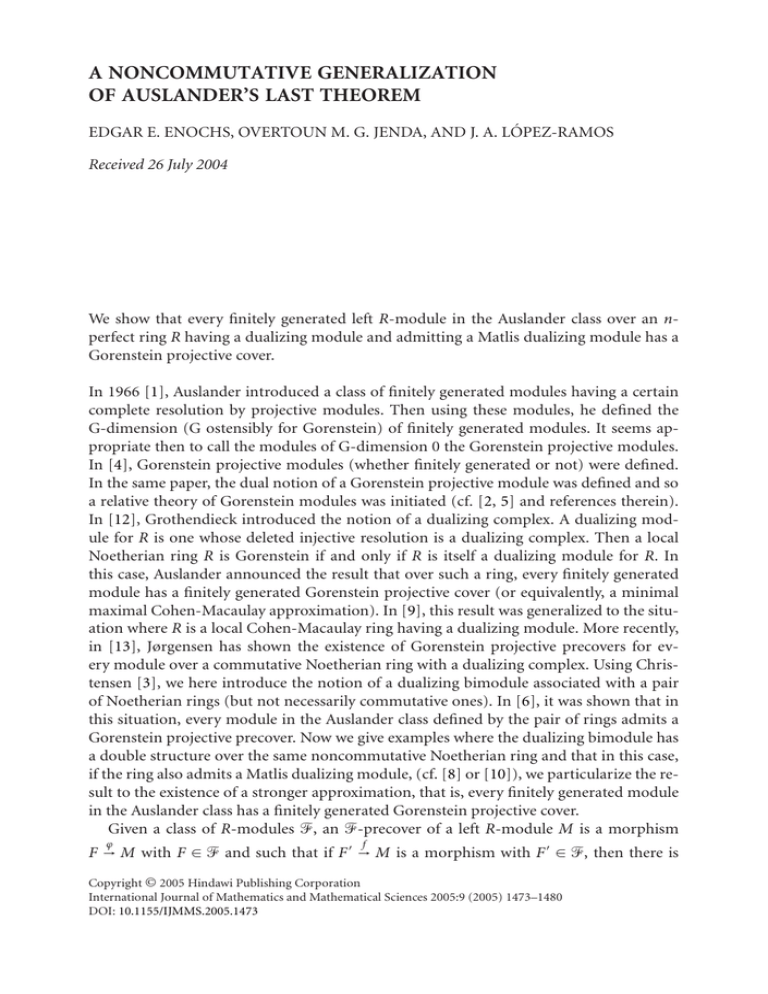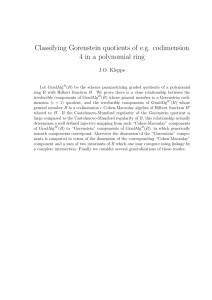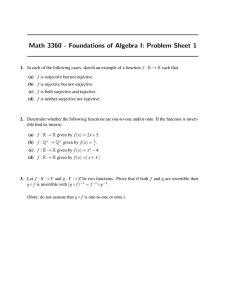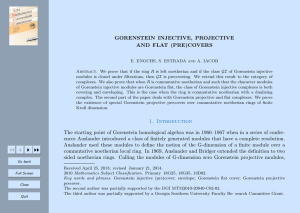A NONCOMMUTATIVE GENERALIZATION OF AUSLANDER’S LAST THEOREM
advertisement

A NONCOMMUTATIVE GENERALIZATION OF AUSLANDER’S LAST THEOREM EDGAR E. ENOCHS, OVERTOUN M. G. JENDA, AND J. A. LÓPEZ-RAMOS Received 26 July 2004 We show that every finitely generated left R-module in the Auslander class over an nperfect ring R having a dualizing module and admitting a Matlis dualizing module has a Gorenstein projective cover. In 1966 [1], Auslander introduced a class of finitely generated modules having a certain complete resolution by projective modules. Then using these modules, he defined the G-dimension (G ostensibly for Gorenstein) of finitely generated modules. It seems appropriate then to call the modules of G-dimension 0 the Gorenstein projective modules. In [4], Gorenstein projective modules (whether finitely generated or not) were defined. In the same paper, the dual notion of a Gorenstein projective module was defined and so a relative theory of Gorenstein modules was initiated (cf. [2, 5] and references therein). In [12], Grothendieck introduced the notion of a dualizing complex. A dualizing module for R is one whose deleted injective resolution is a dualizing complex. Then a local Noetherian ring R is Gorenstein if and only if R is itself a dualizing module for R. In this case, Auslander announced the result that over such a ring, every finitely generated module has a finitely generated Gorenstein projective cover (or equivalently, a minimal maximal Cohen-Macaulay approximation). In [9], this result was generalized to the situation where R is a local Cohen-Macaulay ring having a dualizing module. More recently, in [13], Jørgensen has shown the existence of Gorenstein projective precovers for every module over a commutative Noetherian ring with a dualizing complex. Using Christensen [3], we here introduce the notion of a dualizing bimodule associated with a pair of Noetherian rings (but not necessarily commutative ones). In [6], it was shown that in this situation, every module in the Auslander class defined by the pair of rings admits a Gorenstein projective precover. Now we give examples where the dualizing bimodule has a double structure over the same noncommutative Noetherian ring and that in this case, if the ring also admits a Matlis dualizing module, (cf. [8] or [10]), we particularize the result to the existence of a stronger approximation, that is, every finitely generated module in the Auslander class has a finitely generated Gorenstein projective cover. Given a class of R-modules Ᏺ, an Ᏺ-precover of a left R-module M is a morphism ϕ f F → M with F ∈ Ᏺ and such that if F → M is a morphism with F ∈ Ᏺ, then there is Copyright © 2005 Hindawi Publishing Corporation International Journal of Mathematics and Mathematical Sciences 2005:9 (2005) 1473–1480 DOI: 10.1155/IJMMS.2005.1473 1474 A generalization of Auslander’s last theorem g a morphism F → F such that ϕg = f . If whenever F = F and f = ϕ, then g is always an ϕ automorphism, and we say that F → M is an Ᏺ-cover. Ᏺ-preenvelopes and Ᏺ-envelopes are defined dually. A left R-module M is said to be Gorenstein projective if there is an exact sequence · · · −→ P1 −→ P0 −→ P 0 −→ P 1 −→ · · · (1) of projective left R-modules which remains exact whenever HomR (−,P) is applied to it for every projective module P and such that M = Ker(P 0 → P 1 ). Gorenstein injectives are defined dually (cf. [5]). Definition 1 [6, Definition 2.1]. Let R be a right and left Noetherian ringand let R VR be an R − R-bimodule such that End(R V ) = R and End(VR ) = R. Then V is said to be a dualizing module if it satisfies the following three conditions: (i) id(R V ) ≤ r and id(VR ) ≤ r for some integer r, (ii) ExtiR (R V , R V ) = ExtiR (VR ,VR ) = 0 for all i ≥ 1, (iii) R V and VR are finitely generated. The preceding definition is given in [6] for a bimodule S VR , where S and R are left and right Noetherian rings, respectively, but through this paper, we will consider the case S = R. Examples. If R is a Cohen-Macaulay local ring of Krull dimension d admitting a dualizing module Ω (see [7]), then Ω is a dualizing module in this sense. If R is an n-Gorenstein ring (cf. [5, Definition 9.1.9]), then R RR is a dualizing module. Let R = ⊕g ∈G Rg be a strongly graded ring over a finite group G, right and left Noetherian and let Re VRe be a dualizing module (for Re , e ∈ G is the neutral element in G). Then W = R ⊗Re V ⊗Re R is a dualizing module (for R). Let R be right and left Noetherian and let R VR be a dualizing module. Then R[[x]] V [[x]]R[[x]] is a dualizing module. In [11], the authors defined Auslander and Bass classes of modules over a CohenMacaulay ring admitting a dualizing module. We now use the bimodule V to introduce the corresponding classes in a noncommutative setting. Definition 2. Let R be right and left Noetherian and let R VR be a dualizing module. Define the left Auslander class Ꮽl (R) (relative to V ) as those left R-modules M such that TorRi (V ,M) = 0 and ExtiR (V ,V ⊗R M) = 0 for all i ≥ 1 and such that the natural morphism M → HomR (V ,V ⊗R M) is an isomorphism. The right Auslander class Ꮽr (R) is the class of right R-modules M such that TorRi (M,V ) = 0 and ExtiR (V ,M ⊗R V ) = 0 for all i ≥ 1 and such that the natural morphism M → HomR (V ,M ⊗R V ) is an isomorphism. The left Bass class Ꮾl (R) (relative to V ) is defined as those left R-modules N such that ExtiR (V ,N) = 0 and TorRi (V ,HomR (V ,N)) = 0 for all i ≥ 1 and such that the natural morphism V ⊗R HomR (V ,N) → N is an isomorphism. The right Bass class Ꮾr (R) is defined as those right R-modules N such that ExtiR (V ,N) = 0 and TorRi (HomR (V ,N),V ) = 0 for all i ≥ 1 and such that the natural morphism HomR (V ,N) ⊗R V → N is an isomorphism. We recall the following definition from [8]. Edgar E. Enochs et al. 1475 Definition 3. A ring R has a Matlis dualizing module if there is an (R,R)-bimodule E such that R E and ER are both injective cogenerators and such that the canonical maps R → HomR (R ER , R ER ) and R → HomR (ER ,ER ) are both bijections. E will be called a Matlis dualizing module for R. Several examples of Matlis dualizing modules are given in [8]. We now give some additional examples. Examples. If R is left and right Noetherian having a Matlis dualizing module E, then E[x−1 ] is a Matlis dualizing module for R[[x]]. If R is a strongly graded ring over a finite group, right and left Noetherian, and Re ERe is a dualizing module (for Re ), then W = R ⊗Re E ⊗Re R is a dualizing module (for R). In what follows, R will always be a right and left Noetherian ring and if E is a Matlis dualizing module for R, we will denote M ∨ = HomR (M,E) for M ∈ R-Mod or M ∈ Mod-R. Proposition 4. Let R be a ring and let V and E be a dualizing module and a Matlis dualizing module for R, respectively. If M ∈ R-Mod is finitely generated, then M ∈ Ꮽl (R) if and only if M ∨ ∈ Ꮾr (R). Proof. Suppose that M ∈ Ꮽl (R). Since TorRi (V ,M) = 0, then ∨ R ExtiR V ,M ∨ ∼ = Tori (V ,M) = 0 ∀i ≥ 1. (2) i On the other hand, (TorRi (HomR (V ,M ∨ ),V ))∨ ∼ = ExtR (V ,(HomR (V ,M ∨ ))∨ ). But (HomR (V ,M ∨ ))∨ = HomR (HomR (V ,HomR (M,E)),E) ∼ = HomR (HomR (V ⊗R M,E), E) ∼ = (V ⊗R M)vv and since V ⊗R M is finitely generated, (V ⊗R M)∨∨ ∼ = V ⊗R M (cf. [8]), and so we get that ExtiR V , HomR V ,M ∨ ∨ i ∼ = ExtR V ,V ⊗R M = 0 ∀i ≥ 1. (3) Therefore, Tori (HomR (V ,M ∨ ),V ) = 0 for all i ≥ 1. Finally, by hypothesis M ∼ = HomR (V ,V ⊗R M) and so HomR (V ,V ⊗R M)∨ ∼ = M ∨ is an ∨ ∨ ∼ isomorphism. We also know that HomR (V ,M ) ⊗R V = (V ⊗R M) ⊗R V . Therefore, we only have to show that (V ⊗R M)∨ ⊗R V → HomR (V ,V ⊗R M)∨ is an isomorphism to get that HomR (V ,M ∨ ) ⊗R V ∼ = M∨. The functors (V ⊗R M)∨ ⊗R − and HomR (−,V ⊗R M)∨ are both right exact and the natural morphism V ⊗R M ∨ ∨ ⊗R Rn −→ HomR Rn ,V ⊗R M (4) is an isomorphism, and so the morphism is also an isomorphism for finitely generated modules, in particular for V . Conversely, let now N = M ∨ and suppose that N ∈ Ꮾr (R). Since M is finitely genR i i erated, we get that N ∨ ∼ = M. Now Tori (V ,M)∨ ∼ = ExtR (V ,M ∨ ) = ExtR (V ,N) = 0 for all i ≥ 1 and so TorRi (V ,M) = 0 for all i ≥ 1. Moreover, TorRi (HomR (V ,N),V ) = 0 for all i ≥ 1 and so 0 = TorRi HomR (V ,N),V ∨ i ∼ = ExtR V ,HomR (V ,N)∨ . (5) 1476 A generalization of Auslander’s last theorem ∼ V ⊗R M, and therefore Exti (V , But HomR (V ,N)∨ = HomR (V ,M ∨ )∨ ∼ = (V ⊗R M)∨∨ = R V ⊗R M) = 0 for all i ≥ 1. It only remains to show that M → HomR (V ,V ⊗R M) is an isomorphism. Since N ∨ ∈ Ꮾr (R), then HomR (V ,N) ⊗R V → N is an isomorphism, and therefore N∨ ∼ = HomR (V ,N) ⊗R V ∨ ∼ = HomR V ,HomR (V ,N)∨ . (6) Then consider the natural transformation − ⊗R HomR (N,E) −→ HomR HomR (−,N),E . (7) This gives an isomorphism for Rn and since both functors are right exact, it follows that V ⊗R HomR (N,E) ∼ = HomR (HomR (V ,N),E) and so ∼ HomR V ,V ⊗R M M = N ∨ −→ HomR V ,HomR (V ,N)∨ = (8) is an isomorphism. We now recall from [6] that a ring R is said to be left (right) n-perfect if every left (right) flat R-module has projective dimension less than or equal to n. Left perfect rings, commutative Noetherian rings of finite Krull dimension, the universal enveloping algebra ᐁ(g) of a Lie algebra of dimension n, and n-Gorenstein rings are all examples of left n-perfect rings. Also, if R is left n-perfect, then R[x], R[[x]], the crossed product R ∗ ᐁ(g), and the Weyl algebra Ak (R) are left k-perfect for some k (cf. [6]). Proposition 5. Let R be a right and left n-perfect ring, let V and E be a dualizing module of finite left and right injective dimension r and a Matlis dualizing module for R, respectively, and let G ∈ R-Mod be finitely generated. Then G is Gorenstein projective if and only if G∨ is Gorenstein injective. Proof. If G is Gorenstein projective, by [5, Proposition 10.2.6], there exists an exact sequence 0 −→ G −→ Pr+n −→ · · · −→ P0 −→ M −→ 0, (9) where every Pi is a finitely generated projective. Now since G and Pi , i = 0,...,r + n, are in Ꮽl (R) by [6, Proposition 2.3], then M ∈ Ꮽl (R) by [6, Proposition 2.7]. Now, Pi∨ is injective for every i = 0,...,r + n and by the preceding proposition M ∨ ∈ Ꮾr (R), so by [6, Theorem 2.11], G∨ is Gorenstein injective. Conversely, let G∨ be Gorenstein injective. Since G is finitely generated, there exists a flat preenvelope G → F which factors via a finitely generated free module Rk , so we can assume that F is finitely generated free. But then, since R∨ = E, we get that En → G∨ is an injective precover, and so the injective cover of G∨ is Artinian. Then there is an exact sequence in Mod-R, 0 −→ N −→ Er −1 −→ · · · −→ E0 −→ G∨ −→ 0, (10) Edgar E. Enochs et al. 1477 where every Ei is Artinian and injective. Then N ∈ Ꮾr (R) since G∨ and so are Ei , i = 0,...,r − 1. In this way, we see that 0 −→ G∨∨ = G −→ E0∨ −→ · · · −→ Er∨−1 −→ N ∨ −→ 0 (11) is exact with N ∨ ∈ Ꮽl (R) and Ei∨ is projective for every i = 0,...,r − 1 and therefore by [6, Theorem 2.14], G is Gorenstein projective. The following result appears in [6] but we include a proof here for completeness. Theorem 6. Let R be a left n-perfect ring and R VR a dualizing module for R such that ϕ id(R V ),id(VR ) ≤ r. If M ∈ Ꮽl (R), then it has a Gorenstein projective precover G → M → 0 such that pd(Ker(ϕ)) ≤ r − 1. Proof. Let 0 → C → Fr −1 → · · · → F0 → M → 0 be a (partial) projective resolution of M. Then, by [6, Lemma 2.12], C is Gorenstein projective. Now let · · · P1 −→ P0 −→ P 0 −→ P 1 −→ · · · (12) be an exact sequence of projective modules such that C = Ker(P 0 → P 1 ) and it remains exact whenever HomR (−,P) is applied for every projective P. We consider 0 −→ P 0 −→ · · · −→ P r −1 −→ D −→ 0 (13) exact. Then we have a commutative diagram: 0 C P0 ··· P r −1 D 0 (14) 0 C F r −1 ··· F0 M 0 The associated complex to this diagram (i.e., the mapping complex) 0 −→ C −→ C ⊕ P 0 −→ · · · −→ F0 ⊕ D −→ M −→ 0 (15) is exact and has as a subcomplex the exact sequence 0 → C → C → 0. Then quotient complex 0 −→ P 0 −→ · · · −→ F0 ⊕ D −→ M −→ 0 (16) is exact and all of its terms are projective except perhaps F0 ⊕ D. Now if 0 → L → F0 ⊕ D → M → 0 is exact with pd(L) < ∞, then pd(L) ≤ r − 1. Since F0 ⊕ D is Gorenstein projective and Ext1R (X,L) = 0 for every Gorenstein projective X, it follows that F0 ⊕ D → M is the desired precover. Given a class Ꮿ of R-modules, we let ⊥ C be the class of R-modules F such that Ext1R (F, C) = 0 for every C ∈ Ꮿ. We let C ⊥ be the class of R-modules F such that Ext1R (C,F) = 0 for every C ∈ Ꮿ. A pair of classes of R-modules (Ᏺ,Ꮿ) is called a cotorsion theory if Ᏺ⊥ = Ꮿ and ⊥ Ꮿ = Ᏺ. A cotorsion theory is said to be complete if for every R-module M, 1478 A generalization of Auslander’s last theorem there is an exact sequence 0 → M → C → F → 0 such that C ∈ Ꮿ and F ∈ Ᏺ, or equivalently if there is an exact sequence 0 → C → F → M → 0 such that C ∈ Ꮿ and F ∈ Ᏺ, which is equivalent to say that every R-module has a special Ᏺ-precover and a special Ꮿ-preenvelope (cf. [5]). A cotorsion theory is said to be perfect if every R-module has an Ᏺ-cover and a Ꮿ-envelope. Now since R is left Noetherian, then Hom(−, −) is left balanced by Inj × Inj on RMod × R-Mod, and therefore we can compute left derived functors of HomR (−, −) using left injective resolutions in the second variable constructed with injective covers or right injective resolutions in the first one (cf. [5, Example 8.3.5]). We will denote them by 0 Exti (−, −) i ≥ 0 and Ext (M,N), and Ext0 (M,N) will denote the cokernel and the kernel of the natural morphism ExtR0 (M,N) −→ HomR (M,N). (17) Theorem 7. Let R be a right n-perfect ring and let R VR be a dualizing module for R such that id(R V ),id(VR ) ≤ r. If ᏸ and GorInj denote the classes of right R-modules of finite injective dimension and Gorenstein injective, then (ᏸ,GorInj) is a perfect cotorsion theory of Ꮾr (R). Proof. Suppose that L ∈ Ꮾr (R) ∩ ⊥ GorInj. Then Ext1R (L,G) = 0 for every G Gorenstein injective. Now if G is Gorenstein injective, then there exists an exact sequence 0 → G → 0 E0 → G → 0 with E0 injective and G Gorenstein injective. By [5, Theorem 8.2.7], ExtR (L, R 1 R G) ∼ = ExtR (L,G ) = 0 for every Gorenstein injective G. Analogously, Ext1 (L,G) ∼ = Ext0 (L, G ) = 0 and by induction, ExtRi (L,G) = 0 for all i ≥ 1 and for every Gorenstein injective G. Now let 0 → L → E0 → · · · → Er+n → C → 0 be a (partial) injective resolution of L. By [6, Lemma 2.9], C is Gorenstein injective and so ExtRn+r (L,G) = 0 by the above. Therefore HomR Er+n+1 ,C −→ HomR Er+n ,C −→ HomR Er+n−1 ,C (18) is exact and so C is a direct summand of Er+n which shows that id(L) < ∞. If L ∈ ᏸ, then it is immediate that Ext1R (L,G) = 0 for every Gorenstein injective G. Suppose now that G ∈ Ꮾr (R) ∩ L⊥ . Then by [6, Theorem 2.11], G is Gorenstein injective. If G is Gorenstein injective, then it is immediate that G ∈ ᏸ⊥ . Therefore (ᏸ,GorInj) is a cotorsion theory. By [6, Theorem 2.16], it is complete. Finally, since R is right Noetherian, ᏸ is closed under direct limits and so by [5, Theorem 7.2.6], (ᏸ,GorInj) is perfect. Theorem 8. Let R be a left and right n-perfect ring admitting a Matlis dualizing module and let R VR be a dualizing module for R such that id(R V ),id(VR ) ≤ r. If M ∈ Ꮽl (R) is finitely ϕ generated, then M has a Gorenstein projective cover G → M such that G is finitely generated and pd(Ker(ϕ)) ≤ r − 1. Proof. By Theorem 6, there is an exact sequence 0 → L → G → M → 0 with G Gorenstein projective and pd(L) ≤ r − 1, which can be supposed finitely generated. Then if 0 → M ∨ → G∨ → L∨ → 0 is exact with G∨ Gorenstein injective by Proposition 5 and id(L∨ ) < ∞, therefore HomR G∨ ,N −→ HomR M ∨ ,N −→ Ext1R L∨ ,N = 0 (19) Edgar E. Enochs et al. 1479 is exact for every Gorenstein injective N, which gives that M ∨ → G∨ is a Gorenstein injective preenvelope. By the preceding theorem, M ∨ has a Gorenstein injective envelope ϕ : M ∨ → C, which is a summand of G∨ and so C is artinian. But Coker(ϕ) is also a direct summand of L∨ and so id(Coker(ϕ)) ≤ r − 1. Then pd((Coker(ϕ))∨ ) < ∞ and therefore we have an exact sequence 0 −→ Coker(ϕ) ∨ ϕ∨ −→ C ∨ −→ M −→ 0, (20) where C ∨ is Gorenstein projective by Proposition 5 and pd((Coker(ϕ))∨ ) ≤ r − 1. Since ϕ∨ pd((Coker(ϕ))∨ ) < ∞, it follows that C ∨ → M is a Gorenstein projective precover. Finally, ϕ∨ C ∨ → M is the desired cover since C ∨ and M are reflexive. Corollary 9. Let R and M be as in the previous theorem and let G → M be a Gorenstein projective cover. Then pd(M) < ∞ if and only if G → M is a projective cover. Proof. Suppose that pd(M) < ∞. Then pd(C) < ∞ and let 0 −→ Pk −→ · · · −→ P0 −→ G −→ 0 (21) be a projective resolution of G. Since Ext1R (C,P) = 0 for every projective P, it follows that the sequence splits and so G is projective. The converse is immediate. Corollary 10. Let R and V be as in the previous theorem and let M ∈ Ꮽl (R) be finitely generated. Then the minimal Gorenstein projective resolution of M is of the form 0 −→ Pk −→ · · · −→ P1 −→ G0 −→ M −→ 0, (22) where Pi is projective for every i = 1,...,k and k ≤ r. Proof. By [6, Corollary 2.13], M ∈ Ꮽr (R) if and only if there is an exact sequence 0 −→ Gk −→ · · · −→ G0 −→ M −→ 0, (23) where every Gi , i = 0,...,k, is Gorenstein projective and k ≤ r. Now the result follows from the preceding corollary. Acknowledgment The third author was supported by BFM2002-02717 Grant and Junta de Andalucı́a FQM 0211. References [1] [2] M. Auslander, Anneaux de Gorenstein, et torsion en algèbre commutative, Séminaire d’Algèbre Commutative dirigé par Pierre Samuel, 1966/1967. Texte rédigé, d’après des exposés de Maurice Auslander, Marquerite Mangeney, Christian Peskine et Lucien Szpiro. École Normale Supérieure de Jeunes Filles, Secrétariat mathématique, Paris, 1967 (French). L. W. Christensen, Gorenstein Dimensions, Lecture Notes in Mathematics, vol. 1747, Springer, Berlin, 2000. 1480 [3] [4] [5] [6] [7] [8] [9] [10] [11] [12] [13] A generalization of Auslander’s last theorem , Semi-dualizing complexes and their Auslander categories, Trans. Amer. Math. Soc. 353 (2001), no. 5, 1839–1883. E. E. Enochs and O. M. G. Jenda, Gorenstein injective and projective modules, Math. Z. 220 (1995), no. 4, 611–633. , Relative Homological Algebra, De Gruyter Expositions in Mathematics, vol. 30, Walter de Gruyter, Berlin, 2000. E. E. Enochs, O. M. G. Jenda, and J. A. López-Ramos, Dualizing modules and n-perfect rings, Proc. Edinb. Math. Soc. (2) 48 (2005), no. 1, 75–90. E. E. Enochs, O. M. G. Jenda, and J. Z. Xu, Foxby duality and Gorenstein injective and projective modules, Trans. Amer. Math. Soc. 348 (1996), no. 8, 3223–3234. , Lifting group representations to maximal Cohen-Macaulay representations, J. Algebra 188 (1997), no. 1, 58–68. , A generalization of Auslander’s last theorem, Algebr. Represent. Theory 2 (1999), no. 3, 259–268. E. E. Enochs, J. A. López-Ramos, and B. Torrecillas, On Matlis dualizing modules, Int. J. Math. Math. Sci. 30 (2002), no. 11, 659–665. H.-B. Foxby, Gorenstein dimensions over Cohen-Macaulay rings, Proc. International Conference on Commutative Algebras (W. Bruns, ed.), Universitat Osnabrück, Osnabrück, 1994, pp. 59–63. R. Hartshorne, Local Cohomology, Lecture Notes in Mathematics, no. 41, Springer, Berlin, 1967, a seminar given by A. Grothendieck, Harvard University, 1961. P. Jørgensen, The Gorenstein projective modules are precovering, preprint. Edgar E. Enochs: Department of Mathematics, College of Arts and Sciences, University of Kentucky, Lexington, KY 40506-0027, USA E-mail address: enochs@ms.uky.edu Overtoun M. G. Jenda: Department of Mathematics and Statistics, College of Sciences and Mathematics, Auburn University, AL 36849-5310, USA E-mail address: jendaov@auburn.edu J. A. López-Ramos: Departamento de Álgebra y Análisis, Facultad de Ciencias Experimentales, Matemático, Universidad de Almerı́a, 04120 Almerı́a, Spain E-mail address: jlopez@ual.es






